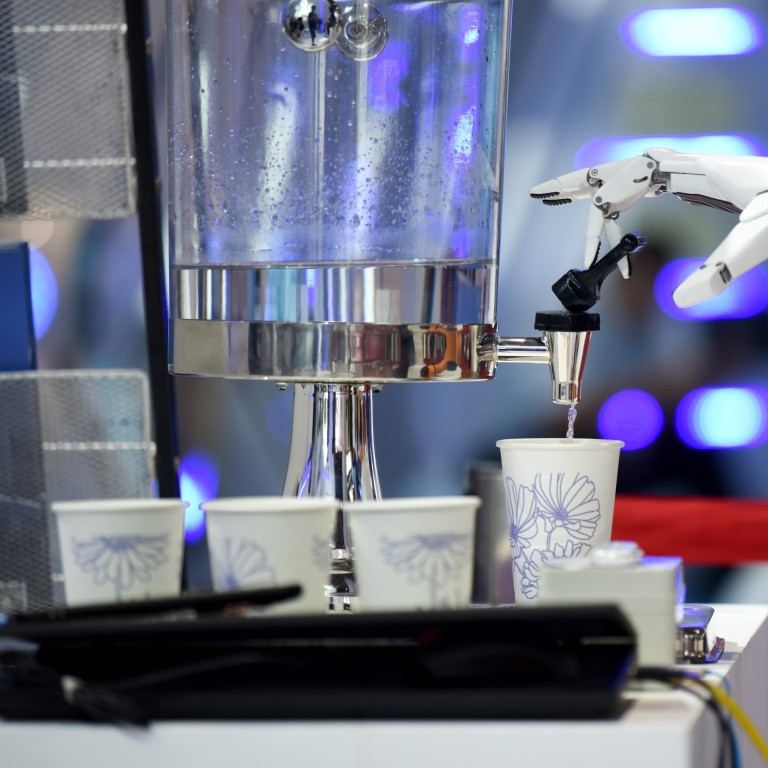
China can excel in consumer robotics, says Credit Suisse Asset Management specialist
- Size of demand difficult to estimate as market is emerging, says senior portfolio manager Angus Muirhead
- China has yet to crack high-end market where consistent and accurate movements are required
China can become a formidable player in the nascent consumer robotics market, where precision of movements is not as important as with industrial robotics.
“The big opportunities are in the lower price segment, which I think is going to be a much bigger market than what we have today. And it is a good place [for Chinese manufacturers] to learn before making the move up [to the higher-end market],” Angus Muirhead, senior portfolio manager at Credit Suisse Asset Management, said in an interview on the sidelines of the bank’s Asian investment conference in Hong Kong this week.
While China is already one of the world’s largest makers of industrial automation machinery, it has yet to crack the high-end market where consistent and accurate movements are required, in some cases, such as the semiconductor industry, down to one-tenth of a millimetre.
“China is catching up, but the quality is not there yet,” said Muirhead, adding that the biggest technological challenge lay in software that controls robots’ movements.
Muirhead manages the CS (Lux) Global Robotics equity fund, which recorded returns of 45.7 per cent in 2017, negative 6.8 per cent last year and 16 per cent from the start of this year to March 17, according to trustnet.com.
China no match for US unicorns in AI, big data and robotics as it continues to play catch-up in R&D, says Credit Suisse
Making coffee, taking restaurant orders and answering customer queries in shopping malls, banks, hotels and hospitals are examples of largely untapped opportunities for customer service provision applications, previously prohibitive because of high costs of both the machines and their repair and maintenance.
Estimates of the size of such demand are, however, difficult given the market is emerging and involves a large number of potential applications.
“Robotics technology is getting much cheaper and smarter than five to 10 years ago, due to rapid advancement of computer processing power and data storage,” said Muirhead. “It is a difficult sell initially to first-time robot users, but it is starting to happen.”
Chinese developers’ New Year’s resolution – diversify into robotics, green cars and Beijing’s other pet projects
He said some easy to use, smaller service robots are sold for US$10,000 to US$20,000 each – prices one-tenth that of traditional robots that require specialist technicians to set up and maintain.
He said the lower price segment was an area that Chinese makers could make inroads into quickly, and were unlikely to face competition from the big players of the high-end market, which is dominated by oligopolies supplying semiconductor producers and tier 1 and tier 2 vehicle makers.
These suppliers include Swiss-Swedish giant ABB, Japan’s Fanuc and Germany’s Kuka, which was acquired by Guangdong-based Midea Group two years ago.
‘Made In China 2025’: a peek at the robot revolution under way in the hub of the ‘world’s factory’
China has been the world’s largest industrial robotics market since 2013, with 137,900 units sold and a global share of 36 per cent in 2017, larger than the Americas and Europe combined, according to the International Federation of Robotics. Annual growth in the four years to 2021 is projected at 21 per cent.
Chinese robot makers sold 34,700 units in 2017, up 29 per cent from a year earlier, according to the China Robot Industry Alliance.
But their growth was eclipsed by foreign suppliers’ 72 per cent increase, including their China-produced output, for the first time since the country started making robots around a decade ago. This resulted in Chinese makers’ global market share falling to 25 per cent from 31 per cent in 2016, IFR data shows.

